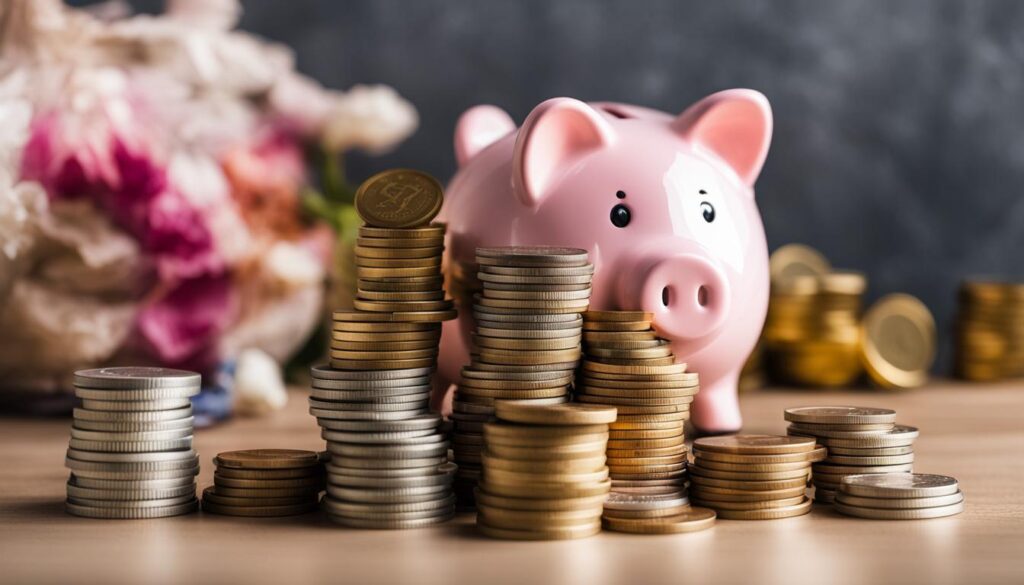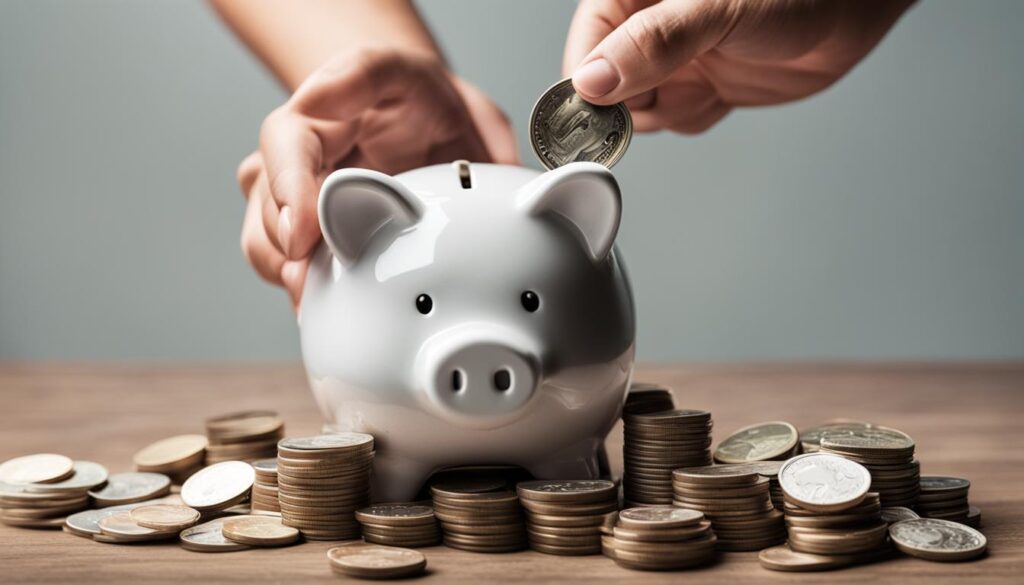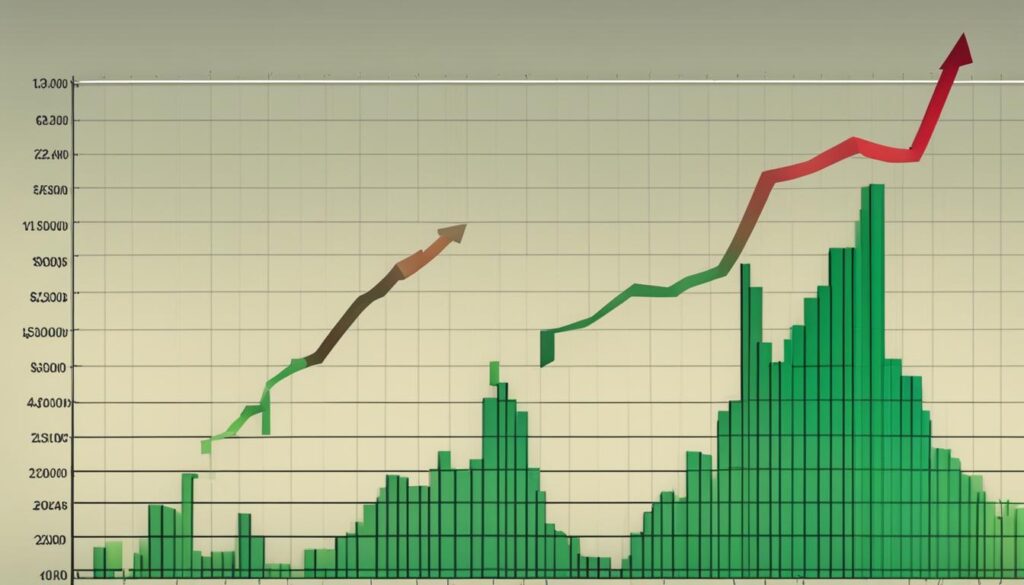In this article, we explore the impact of the Diderot Effect on consumer spending and the endless upgrading cycle. We delve into the current spending trends in the 2024 election cycle and how it compares to previous years. Additionally, we discuss strategies to break free from the upgrade cycle and prioritize savings for a more financially secure future.
Key Takeaways:
- The Diderot Effect can lead to a cycle of continuous upgrading, driving consumer spending.
- Spending in the 2024 election cycle has exceeded $1 billion, with a shift in ad spending among Republican candidates.
- Breaking free from the upgrade cycle requires developing better financial habits, such as trimming expenses and avoiding impulse purchases.
- Building strong savings is crucial for achieving financial goals and providing a safety net in case of emergencies.
- The cost of running for political office continues to rise, presenting financial challenges for candidates.
The Impact of The Diderot Effect
The Diderot Effect refers to the phenomenon where acquiring a new possession leads to a cycle of continuous upgrading. As consumers, we often fall prey to the allure of the latest gadgets, fashion trends, and home decor. The moment we bring a new item into our lives, it has a ripple effect, causing us to feel dissatisfied with our existing possessions and prompting us to seek better, newer, and more expensive alternatives.
This constant desire to upgrade can have a significant impact on consumer spending habits. The pressure to keep up with the latest trends and maintain a certain lifestyle can lead to financial strain. We may find ourselves constantly splurging on items we don’t truly need or sacrificing our long-term financial goals in pursuit of immediate gratification.
To illustrate the extent of this effect, let’s consider an example:
“Jane recently bought a new smartphone. While initially, she was satisfied with her purchase, she soon found herself desiring a better camera and faster processing speed. Soon enough, she was browsing online for the latest model, willing to spend a significant amount of money to satisfy her newfound desire. The cycle continued as each new purchase sparked a desire for an even better version, leaving Jane trapped in a never-ending upgrading cycle.”
This example highlights the powerful grip that The Diderot Effect can have on our spending habits. It’s important to recognize this pattern and take steps to break free from it in order to regain control over our finances and work towards achieving our larger financial goals.
| Effects of The Diderot Effect | Consequences |
|---|---|
| Continuous upgrading | Financial strain |
| Pressure to keep up with trends | Sacrificing long-term financial goals |
| Compulsive buying behavior | Lack of satisfaction and fulfillment |
Recognizing the detrimental impact of The Diderot Effect on our financial well-being is the first step towards making positive changes. By developing better financial habits, prioritizing our spending choices, and being mindful of the allure of constant upgrading, we can break free from the cycle and focus on building a more secure and fulfilling financial future.
Additional Strategies to Combat The Diderot Effect
- Create a budget and stick to it.
- Practice mindful spending by considering the long-term value of purchases.
- Focus on experiences rather than material possessions.
- Regularly assess and declutter your belongings to avoid the accumulation of unnecessary items.
- Build a savings habit to provide a buffer against impulsive spending and unexpected expenses.
Breaking Free from the Upgrade Cycle
Breaking free from the buy-and-buy cycle requires developing better financial habits. By implementing a few simple strategies, individuals can save money, prioritize their financial goals, and break the cycle of endless upgrading.
One effective way to break the cycle is by trimming monthly expenses. Take a close look at your budget and identify areas where you can cut back. This could mean canceling unnecessary subscriptions, reducing dining out expenses, or finding more affordable alternatives for everyday items.
Avoiding tempting purchases is another key habit to adopt. Before making a purchase, ask yourself if it aligns with your long-term financial goals. Will it truly add value to your life or is it merely a fleeting desire? By waiting 24 hours and considering the impact on your finances, you can avoid impulse purchases and save money in the long run.
Deposit any extra cash or rebates directly into your savings account. Instead of using this money for immediate gratification, use it to build your financial security. By saving these unexpected windfalls, you’ll be one step closer to achieving your financial goals.
Implementing an all-cash budget can also be a powerful tool in breaking the upgrade cycle. By using cash for your everyday expenses, you become more aware of your spending habits and can better track where your money is going. This can help you identify areas where you can cut back and prioritize saving.
Lastly, learning how to cook affordable meals at home can significantly reduce your monthly expenses. Eating out can quickly add up, but by preparing your meals at home, you can save money and still enjoy delicious and nutritious food. This habit not only helps you break the upgrade cycle but also promotes a healthier lifestyle.
By adopting these financial habits and making conscious choices about your spending, you can break free from the buy-and-buy cycle. Prioritizing savings and focusing on long-term goals will ultimately lead to financial stability and a brighter financial future.
The Importance of Savings
The importance of savings cannot be overstated when it comes to achieving financial goals and building a secure future. A 2017 Bankrate survey revealed that only 31% of Americans have enough savings to cover six months’ worth of expenses or plan for significant purchases. This statistic highlights the need for individuals to prioritize saving and develop better financial habits.
Savings serve as a safety net during unforeseen emergencies and provide individuals with greater control over their financial well-being. They offer the freedom to pursue larger financial goals, such as buying a car, owning a home, or funding education. Without sufficient savings, individuals may find themselves in stressful situations, relying on debt or struggling to meet essential expenses.
Building a healthy savings account requires discipline and commitment. It involves making conscious choices to prioritize saving over unnecessary spending. By trimming monthly expenses, avoiding tempting purchases, and focusing on long-term goals, individuals can start building their savings and working towards financial stability. Depositing extra cash or rebates into savings, implementing an all-cash budget, and waiting 24 hours before making impulse purchases are effective strategies that can help individuals develop better financial habits.
Ultimately, savings provide individuals with the financial security and freedom to pursue their dreams. By making saving a priority and adopting smart financial habits, individuals can lay the foundation for a brighter and more secure future.

The Importance of Savings
| Statistics | |
|---|---|
| Percentage of Americans with enough savings to cover six months’ worth of expenses or plan for large purchases: | 31% |
| Benefits of savings: | – Safety net during emergencies – Greater control over financial well-being – Ability to pursue larger financial goals |
| Strategies for building savings: | – Trimming monthly expenses – Avoiding tempting purchases – Depositing extra cash or rebates into savings – Implementing an all-cash budget – Waiting 24 hours before making impulse purchases |
| Financial security and freedom: | Savings provide individuals with the financial security and freedom to pursue their dreams. |
Tips for Building Stronger Financial Habits
Building stronger financial habits is essential for achieving long-term financial stability and reaching your savings goals. By implementing a few simple strategies, you can prioritize saving, avoid unnecessary expenses, and develop positive spending habits. Here are some practical tips to help you build stronger financial habits:
Trim Monthly Expenses
Take a close look at your monthly expenses and identify areas where you can cut back. Consider canceling unnecessary subscriptions, reducing dining out expenses, and finding more affordable alternatives for everyday expenses. Small changes can add up to significant savings over time.
Avoid Tempting Purchases
When you’re tempted to make an impulse purchase, take a step back and ask yourself if it aligns with your long-term financial goals. Avoid the urge to splurge on unnecessary items and focus on spending your hard-earned money on things that truly matter to you.
Deposit Extra Cash into Savings
If you receive unexpected cash, such as a bonus or a tax refund, consider depositing it directly into your savings account instead of using it for discretionary spending. This will help you build up your savings faster and stay on track with your financial goals.
Implement an All-Cash Budget
Using cash for your daily expenses can help you become more conscious of your spending habits. Set a weekly or monthly budget for discretionary expenses, withdraw that amount in cash, and only spend what you have. This will prevent overspending and help you stay within your budget.
Focus on Savings Goals
Set specific savings goals and work towards achieving them. Whether it’s saving for a down payment on a house, an emergency fund, or a dream vacation, having clear goals can help you stay motivated and focused. Visualize the end result and remind yourself of the long-term benefits of saving.
By following these tips and developing healthier financial habits, you can take control of your finances and build a solid foundation for a secure financial future.

The Cost of Federal Elections
The cost of federal elections continues to rise, with the 2022 election cycle exceeding $8.9 billion. This amount surpassed the previous record set in the 2018 midterm elections. The ever-escalating spending in elections is driven by lax campaign finance regulations and oversight. Political parties, candidates, PACs, and outside groups all contribute to the high spending on campaign advertisements and fundraising efforts.

The increasing cost of federal elections reflects the vast sums of money poured into advertising, media campaigns, and promotional activities. Candidates and parties strive to capture the attention and support of voters through various means, including television, radio, digital platforms, and direct mail. These expenditures contribute to the overall rising expenses and highlight the extent to which campaign finance impacts the electoral process.
The 2022 election cycle saw unprecedented levels of spending, with candidates and outside groups investing heavily in political advertisements. This trend underscores the importance of campaign finance reform and the need for greater transparency in the political arena.
As the 2024 election cycle approaches, it is likely that the cost of federal elections will continue to climb. The influence of money in politics raises concerns about the ability of individuals from diverse backgrounds to run for office and have their voices heard. Reforming campaign finance laws and implementing stricter regulations can help curb excessive spending and promote a more equitable electoral process.
Spending Patterns in Federal Elections
In the 2022 election cycle, Republican candidates outspent their Democratic counterparts with a total expenditure of $4.2 billion compared to $4 billion. However, when we delve into specific spending categories, we see different patterns emerge. Democratic candidates and party committees allocated more funds towards staff salaries and media spending, while Republicans focused more on fundraising efforts.
The breakdown of spending is as follows:
| Republican | Democratic | |
|---|---|---|
| Fundraising | $2.5 billion | $1.8 billion |
| Staff Salaries | $500 million | $700 million |
| Media Spending | $1 billion | $1.5 billion |
These spending patterns underscore the different strategies employed by each party in their campaigns. Republicans focused their resources on fundraising, channeling significant funds into their campaign war chests. On the other hand, Democrats allocated more funds towards hiring staff and launching media campaigns, recognizing the importance of effective messaging and public outreach.
These spending patterns in federal elections showcase the complexity of campaign finance and the diverse approaches taken by political parties to secure victory.
The Growing Cost of Running for Office
The cost of running for political office has been steadily increasing, posing challenges for candidates and highlighting the escalating expenses associated with seeking public office. In the 2022 election cycle, the average cost to run for a U.S. Senate seat was $13.5 million, a significant increase from $10.8 million in 2018. However, the average cost of congressional elections slightly decreased to $1.8 million from $1.9 million in the previous cycle.
These figures demonstrate the financial burden candidates face in financing their campaigns and the rising costs of political campaigns. Running for office requires significant fundraising efforts to cover expenses such as advertising, staff salaries, travel, and event costs.

Table: Average Cost of Running for Office
| Election Cycle | Average Cost for U.S. Senate | Average Cost for Congressional Elections |
|---|---|---|
| 2022 | $13.5 million | $1.8 million |
| 2018 | $10.8 million | $1.9 million |
As campaigns become more competitive, candidates need to allocate substantial resources to fundraising activities. They rely on donations from individuals, political action committees (PACs), and other organizations to finance their campaigns. Without adequate funding, candidates may struggle to reach voters effectively and communicate their messages.
The growing cost of running for office underscores the importance of campaign financing and fundraising efforts. Candidates must navigate the complex landscape of campaign finance regulations and work diligently to attract financial support from diverse sources. By doing so, they can secure the necessary resources to run competitive campaigns and pursue public office.
Influence of Outside Spending
Outside spending in federal elections has reached unprecedented levels, with over $2.3 billion spent by outside groups in the 2022 election cycle. This includes spending by politically active nonprofits and other organizations that are not required to disclose their donors. The rise of outside spending has raised concerns about the influence of dark money in politics, as it allows wealthy individuals and corporations to sway elections without transparency.
According to data from the Center for Responsive Politics, outside spending accounted for nearly 40% of the total spending in the 2022 election cycle. This highlights the significant role that outside groups play in shaping the outcomes of elections. The use of dark money, which refers to undisclosed contributions, further complicates the issue, as it makes it difficult to trace the true source of funding and understand the motives behind the spending.
Small-dollar contributions also played a notable role in the 2022 election cycle, accounting for 18% of all funds raised. This demonstrates the ongoing grassroots support for candidates and causes, as individuals contribute smaller amounts to support campaigns they believe in. However, the decrease in contributions from female donors compared to previous years is a concerning trend that merits further analysis and attention.
“The rise of outside spending and dark money in elections raises questions about the integrity of our democratic process. Without transparency and accountability, it becomes increasingly difficult for voters to make informed decisions and hold elected officials accountable for their actions.”
– Campaign Finance Expert
Overall, the influence of outside spending in federal elections cannot be ignored. As the amount of money flowing into campaigns continues to increase, it is important for lawmakers and citizens alike to closely examine the impact of outside groups and dark money on our democracy. Transparency and campaign finance reforms may be necessary to address the concerns associated with excessive outside spending and ensure a fair and equitable electoral system.
**Table: Outside Spending in the 2022 Election Cycle**
| Outside Spending Category | Amount (in billions) |
|————————–|———————|
| Politically Active Nonprofits | $1.5 |
| Other Outside Groups | $0.8 |
| Dark Money Contributions | $0.5 |
| Small-Dollar Contributions | 18% of total funds raised |
Conclusion
The Diderot Effect can have a significant impact on consumer spending habits, leading to a cycle of continuous upgrading. However, individuals have the power to break free from this endless upgrading by developing better financial habits and prioritizing savings.
By trimming monthly expenses, avoiding impulse purchases, and depositing extra cash into savings, individuals can take control of their finances and avoid the negative effects of the upgrade cycle. Implementing an all-cash budget, setting clear savings goals, and waiting 24 hours before making impulse purchases can also help individuals make wise spending choices and achieve long-term financial stability.
It is important to recognize the influence of the Diderot Effect and take proactive steps to counteract it. By staying mindful of our spending choices and focusing on long-term financial goals, we can break free from the cycle of endless upgrading and achieve financial independence. By prioritizing financial habits and savings, individuals can build a brighter future and avoid the pitfalls of constant consumerism.
FAQ
What is the Diderot Effect?
The Diderot Effect refers to the phenomenon where acquiring a new possession leads to a cycle of continuous upgrading.
How does the Diderot Effect impact consumer spending?
The Diderot Effect can have a significant impact on consumer spending habits, as people feel compelled to constantly upgrade their possessions.
How can individuals break free from the upgrade cycle?
Individuals can break free from the upgrade cycle by developing better financial habits, prioritizing savings, and being mindful of their spending choices.
Why is savings important?
Building a solid savings account is crucial for achieving financial goals, providing a safety net in case of emergencies, and allowing individuals to have more control over their financial future.
What are some tips for building stronger financial habits?
Tips for building stronger financial habits include trimming monthly expenses, avoiding tempting purchases, depositing extra cash or rebates into savings, implementing an all-cash budget, focusing on savings goals, waiting 24 hours before making impulse purchases, and learning how to cook affordable meals at home.
How much is spent on federal elections?
The cost of federal elections continues to rise, with the 2022 election cycle exceeding $8.9 billion.
How do spending patterns differ in federal elections?
In the 2022 election cycle, Republicans outspent Democrats with a total expenditure of $4.2 billion, but Democrats allocated more funds towards staff salaries and media spending.
How much does it cost to run for political office?
The average cost to run for a U.S. Senate seat during the 2022 election cycle was $13.5 million, while the average cost of congressional elections slightly decreased to $1.8 million.
What is the influence of outside spending in elections?
Outside spending in federal elections has reached unprecedented levels, with over $2.3 billion spent by outside groups. This includes politically active nonprofits and organizations that are not required to disclose their donors.
What is the conclusion of the Diderot Effect and financial habits?
The Diderot Effect can drive consumer spending, but individuals can break free from this cycle by developing better financial habits, prioritizing savings, and being mindful of their spending choices.
How Can Changing Your Mindset Help with Managing Your Budget?
Changing your mindset can have a profound impact on managing your budget. When you change your money habits, you open yourself up to new possibilities. By shifting your perspective and adopting a more mindful approach, you become aware of unnecessary expenses and develop better financial discipline. This change enables you to make smarter decisions, prioritize your spending, and ultimately achieve your budgeting goals more effectively.
Source Links
- https://www.insideradio.com/free/spending-tops-1-billion-in-2024-election-cycle/article_9a420a6a-77ba-11ee-8076-2bf1e7d19751.html
- https://www.opensecrets.org/news/2023/02/midterms-spending-spree-cost-of-2022-federal-elections-tops-8-9-billion-a-new-midterm-record/
- https://www.usbank.com/financialiq/manage-your-household/personal-finance/how-to-achieve-your-dreams-by-breaking-the-spending-cycle.html


Pingback: Educational Investments: When Persistence Costs More Than Change – Straight Fire Money